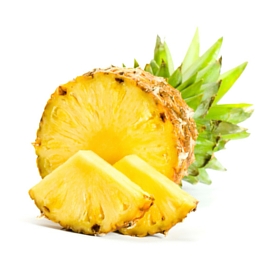
Christopher Columbus was the first person to introduce pineapples to Europe. In 1493 he found pineapples while exploring the Caribbean Islands, He brought some back to Queen Isabella of Spain who fell in love with the sweet tropical fruit. Europeans tried very hard to grow pineapples, but this effort was met with very little success. Pineapples require a tropical climate and are grown in Costa Rica, Brazil, Ecuador and China. Even though, the pineapple was introduced late to the Hawaiian Islands, it now leads the world in production.
To the Caribe, the pineapple symbolized hospitality, and the Spanish explorers quickly learned they were welcome if a pineapple was placed at the entrance of a village. This symbolism spread to Europe, then to Colonial North America, where it became the custom to carve the shape of a pineapple into the columns at the entrance of a plantation and onto the posts of beds in guest rooms.
As an international symbol of welcome, the pineapple is certainly a welcome member of the fruit family for it’s delicious taste and nutritional benefits. Pineapples are a good source of vitamin C, a commonly known antioxidant that protects the body from free radical damage and boosts the immune system. Not only does vitamin C help fend off the colds and infections, but a recent study shows that vitamin C can help reduce your risk of gingivitis and periodontal disease too.
Pineapple also contains high levels of an enzyme called bromelain. Bromelain is a natural anti-inflammatory, and it can help relieve rheumatoid arthritis symptoms, sore throat pain, and reduce postoperative swelling. Additionally, the bromelain in pineapple helps break down the amino acid bonds in proteins, which promotes good digestion. Finally, pineapple is full of manganese, a trace mineral that is in very few foods. Manganese protects against osteoporosis.
Age to introduce: about 10-12 months (pureed).
Note: Dried pineapple — Pineapple is the one dried fruit that is typically coated with sugar. Its sugar content is so high that you might as well be eating candy. We recommend reading the labels and avoiding the sugar-coated brands.
Toddler Treat: Pineapple Kabobs
This recipe is super easy and tasty. Make a platter for a party or make a few for your child’s snack. Mini kabobs look fancy and are fun to make – even little fingers can help assemble them!
Ingredients:
- Pineapple chunks (½ inch pieces)
- Marble cheese cubes (½ inch pieces)
- Slices of ham cut into 1-inch squares
- Toothpicks or popsicle sticks
Directions:
Assemble the mini-kabobs on a toothpick or popsicle stick in the following manner: Ham square, pineapple chunk, ham square, and a cheese cube.
Veggie version: Substitute teriyaki-flavored baked tofu for the ham/cheese. Baked tofu can easily be sliced into small cubes and is very tasty with the pineapple.
Storage: Refrigerate before serving. Mini kabobs do not keep well in the refrigerator for longer than 3-4 hours.
Pineapple for the family
At the market: Pineapples should be heavy for their size, well-shaped, and fresh-looking with dark green crown leaves. Shells should be dry, crisp, and range in color from greenish-brown to golden brown.
There are four types of pineapples mainly in the markets; Gold, Smooth Cayenne, Red Spanish and Sugar Loaf are the varieties. The Gold variety features an extra sweet flavor, golden color, and higher vitamin C content, but it is often twice the price.
Storage and Ripening: Refrigerate. Does not ripen after harvest.
Preparation: Cutting a fresh pineapple may seem a bit intimidating. But it is really quite easy. To start twist or cut off the crown (leafy part). Cut pineapple in half and then into quarters. Trim off ends and remove core from center of each quarter. Using a paring knife remove shell from fruit. Remove any hard eyes with the end of the vegetable peeler. Cut into bite-size pieces.
Here are a few easy ideas to add pineapple in your meals:
- Toss chopped or crushed pineapple in chicken salad. Serve in Boston lettuce leaves.
- Serve a bowl of fresh pineapple as a side dish to BBQ meats and veggies. Or even better, make a pineapple salsa by tossing chopped pineapple, onion, and cilantro with some lime juice.
- Grilled pineapple is fabulous! To grill, use strips of pineapple about 1-inch thick or pineapple rings (about 1-inch thick). Brush both sides of the pineapple with olive oil. Place on a BBQ grill for 1- 2 minute per side. Serve warm.
- Make a Hawaiian pizza: Spread a pizza crust with pizza sauce. Sprinkle with mozzarella cheese. Top with ham and pineapple chunks. Bake.
- For a tropical twist on drinks, pour pineapple juice into ice cube trays and freeze. Pop the cubes out and add them to other juice drinks or cocktails.


